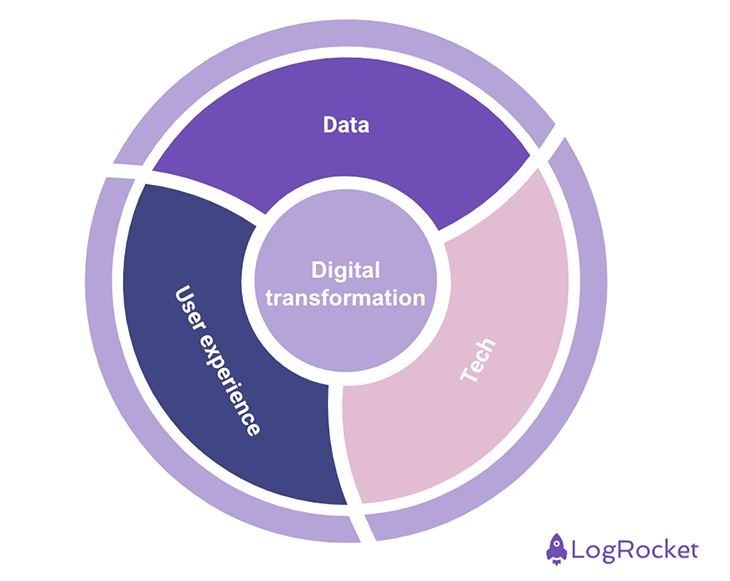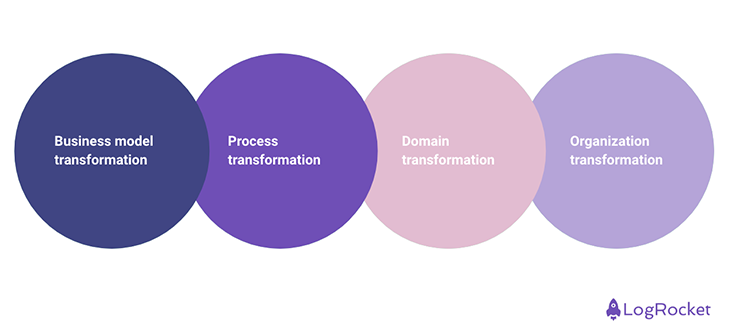One of my favorite books is Exponential Organizations by Salim Ismail. In a nutshell, the author argues that small and niche products can eventually overtake industry leaders, even with fewer resources and market share. The book covers six years of research, examining 100 fast-growing startups such as Airbnb, GitHub, and Tesla.

A key aspect of an exponential organization is what Salim calls “info-enabled acceleration.” In other words, exponential growth comes from organizations that leverage technology, culture, and process as tech economies of scale to deliver disproportionate results on investment. That’s how small can overtake big.
However, Salim’s thesis doesn’t suggest that all large organizations will become obsolete. This is where “digital transformation” comes into play. More than just integrating new technology into a business’s operations, digital transformation is a comprehensive reinvention of how businesses operate, create, and deliver value. It’s a critical factor for survival in today’s economy.
Traditional businesses that embrace digital transformation strategies are better positioned to respond to disruptive technology trends. A well-executed digital transformation strategy leads to an increased capacity for adjustment to changes and the readiness to capitalize on new opportunities.
Engaging with digital transformation is not optional; it’s a necessity for businesses in the modern age. A well-executed digital transformation strategy does more than simply boost your profits; it prepares your organization for sustainable growth.
Taking a step back before diving into digital transformation strategies, it’s essential to clear up some common misconceptions. Three terms often get mixed up when discussing digital: digitization, digitalization, and digital transformation.
Digitization is the process of converting information into a digital format, such as turning paper documents into digital files. Digitalization goes a step further, leveraging this digitized data to improve business processes. It’s about optimizing and augmenting business operations with digital technology.
On the other hand, digital transformation is a holistic approach that involves integrating digital technology into all areas of the business. It’s a change in how a company understands and delivers value to its customers. It’s about agility, iterative thinking, and processes updated to the ever-evolving digital landscape.
A digital transformation strategy is, therefore, a comprehensive organizational overhaul, not just a process upgrade.
Saying that digital transformation is basically a reinvention of the whole business might sound overwhelming, and it is! We can break it down into three smaller, more digestible elements, though: data, technology, and user experience.
Many buzzwords in the industry, such as agility, lean mindset, product thinking, and iterative value delivery, ultimately revolve around the effective application of technology and data-driven decision-making with user experience at the core:

Data is the compass that drives digital transformation. It offers valuable insights into customer behaviors, market trends, and business operations.
Leveraging data effectively can lead to more informed decisions and more effective strategy development. If data is being well used, it’s clear that digital transformation is the way forward.
If data points out the direction, technology is what will take you there. From cloud computing to artificial intelligence, advanced technologies enable businesses to scale processes, services, and workflows that would be otherwise financially impracticable. Much of the exponentiality I mentioned comes from adopting the best tech while using the best processes.
User experience gives meaning to the entire process of digital transformation. Every strategy must be customer-centric; effectively addressing user pain points should come before addressing any business pain points. Enhanced user experience goes beyond good customer service; it involves tailoring products, services, and interactions to meet and exceed customer expectations.
Organizations that have these three supporting values well-defined and prioritized are one step closer to succeeding in their digital transformation journey.
Digital transformation is usually a company effort, impacting all teams across the organization. It might be a direct change such as altering how you work, or an indirect one like having more or less budget.
Either way, there are four main areas in which companies can expect the most changes when planning their digital transformation strategy: business model transformation, process transformation, domain transformation, and organizational transformation.

New tech often entails new opportunities to change revenue streams. Think of migrating from an annual contract revision model to monthly subscriptions charged by credit card. When you undergo digital transformation, it’s expected that you engage with different types of clients or different types of value delivery expectations. Either way, you must adapt your business model accordingly to avoid losing revenue.
This is usually when “agile” comes into place. Rethinking your organization from the bottom up means that you need to rethink how you do work itself.
To be able to respond to the fast-changing market trends, you need to adopt processes that make you nimble when it comes to delivering goods and services. Kanban, scrum, Lean Six Sigma, SAFe — all of those and many others are frameworks that can be adopted or doubled down to transform processes.
With new tech available, beyond business model transformations, we have opportunities to explore new businesses entirely.
Imagine a company that used to provide consultancy, but now they also sell software they used internally to external customers. This is a change of domains that might be partial, meaning that our example company would still provide consultancy, or complete, which would entice the business to pivot definitely.
This is where we see the earlier changes done by a digital transformation strategy. Bringing a workforce from outside the organization that is fluent in digital is paramount to having a well-succeeded strategy.
Organization (or organizational) transformation is when we see the creation of product teams, an increase in the software engineering corps, the hiring of designers, and more. This move often means a change at the head of the company as well: new directors, C-suites, or even a new CEO.
A common misconception is to view the product manager as merely a figurehead leading digital transformation. In reality, the product manager is as much of a cog as any other individual within the organization. The C-level executives are primarily responsible for leading and promoting digital transformation.
The role of the product manager is critical, nonetheless. As stewards of a product’s lifecycle, product managers are uniquely positioned to influence an organization’s digital transformation strategy.
The performance of the product team serves as a display window for the success or failure of a digital transformation strategy. When product teams effectively leverage transformative levers to drive growth, it becomes easier to sell change to more conservative parts of the organization. On the other hand, a faulty product strategy might bring digital transformation to a halt, causing people to grow skeptical about the extent of change that should be happening.
Aligning product vision and digital transformation isn’t a one-time deal. It’s an iterative process — a feedback loop where learnings from each product iteration refine and improve the digital transformation strategy. Well-executed agile methodologies play a central role in introducing this iterative approach to unfamiliar teams. The “product owner” aspect of the product manager facilitates the transition from outdated delivery practices to a more effective, flexible, and rapid approach to product development.
While it might seem that product managers lean more towards project management during digital transformation, it’s important to keep in mind that this is a lengthy process. Product teams should focus on the long run rather than expecting C-level executives to suddenly embrace lean methodologies overnight.
By remembering the triad — data, technology, and user experience (UX) — it’s easy to see why product managers are so important. Positioned at the center of a product team, the product manager should champion the digital transformation strategy. Although leadership does not rest solely on their shoulders, they serve as the face, arms, and voice of this fundamental change.
Embarking on a digital transformation journey is a bold move, and like any significant change, it’s prone to face resistance. Human beings are creatures of habit, and organizations are no different. It can be difficult to convince people, especially leadership, to break away from familiar processes and embrace a whole new culture. Change, however, is the essence of digital transformation, and instilling an openness to change is crucial.
People opposed to change often bring up operational continuity as a concern. With so many processes transforming, there’s indeed a risk that day-to-day operations may get disrupted. Adopting a “slow and steady” approach helps here, allowing for incremental changes rather than revolutionary ones. Small gains not only help rally support but also avoid accidents that could halt the entire operation.
The need to balance short-term results with long-term strategy also poses a challenge, and one of the biggest adversaries of digital transformation is time itself. While it’s important to show quick wins to maintain stakeholder confidence and momentum, the true value of digital transformation lies in its long-term impact. It’s common to see amazing initiatives with a good chance of bearing fruit get lost mid-process and never picked up again.
Overcoming these challenges requires a well-thought-out strategy, and that’s when C-level buy-in comes into play. One key aspect of successful transformation is setting and measuring objective success across the entire organization using key performance indicators (KPIs) and objectives and key results (OKRs). These tools provide clear targets and milestones, creating a roadmap for the transformation and the means to gauge progress.
It also falls on leadership — at least on the technical side — to adopt lean and agile approaches to delivery. In lean methodology, the focus is on measuring efficiency rather than outputting software at any cost. This differentiation alone encourages organizations to lean into more data-driven and customer-centric approaches to technology. Coupled with the principles of agility, it enables businesses to respond swiftly and effectively to changes.
The New York Times underwent a significant digital transformation journey over an eight-year period beginning in 2012. Under the leadership of Mark Thompson, president, and CEO, the Times saw its digital readership skyrocket from half a million to nearly 5.7 million subscribers. Its annual revenue from digital-only subscriptions topped $450 million at the end of 2019.
They revisited their entire core business value proposition: news should not be just a list of headlines and hard news stories; instead, it should be a sophisticated cultural object, such as a book or a painting. Despite skepticism and internal struggle, Mark bet that discerning users would pay for better written and reported news, similar to how they would pay more for a better pair of shoes or better TV. This led to the creation of successful products like “NYT Cooking” and “Wirecutter.”
Ultimately, the New York Times pivoted its business model entirely from physical to digital, even repurposing some of its focus to more mobile-native opportunities such as gaming. “Wordle” is one of the most played games in the USA, and it’s a freemium product intended to drive subscriptions.
Adobe is another classic example. Pivoting from a software-as-a-product (SAP) suite to a software-as-a-service (SaaS) platform, Adobe saw skyrocketing revenue growth from 2013 onwards. The transition process was not an easy one, with Shantanu Narayen, Adobe CEO since 2007, facing several hurdles such as an existing complex IT landscape, undocumented third-party integrations, unclean master data, and resistance to changing business processes.
Adobe opted for a “system conversion” approach to its transition, preserving the original system including data, processes, and custom code. This approach was more cost-effective and less disruptive, demonstrating that iterative and “slow and steady” planning beats revolution.
Despite the inherent challenge of working with legacy systems and the need to retain all data in the system, the journey taught Adobe valuable lessons. From the importance of leveraging existing resources to removing redundant processes and harmonizing them, the company managed to redesign its boxed-software business into a primarily cloud-based, always-online service.
Digital transformation is hard, painful, and in some cases, even dangerous for businesses. Nonetheless, it’s a necessity for legacy organizations to stay afloat. In this context, the digital transformation strategy your company develops is more important than the decision to undergo change itself.
This article is just an appetizer on the topic, with an enormous endeavor ahead for any team or leader that wishes to engage with digital transformation. Ismail Salim is essential reading, as well as the upcoming book from Marty Cagan called Transformed.
I wish you “good luck” for those about to embark on this journey, “hang tight” for those going through it right now, and a very enthusiastic “well done” if you’ve already made it!
Featured image source: IconScout

LogRocket identifies friction points in the user experience so you can make informed decisions about product and design changes that must happen to hit your goals.
With LogRocket, you can understand the scope of the issues affecting your product and prioritize the changes that need to be made. LogRocket simplifies workflows by allowing Engineering, Product, UX, and Design teams to work from the same data as you, eliminating any confusion about what needs to be done.
Get your teams on the same page — try LogRocket today.

Most teams fail at autonomy. Learn how clear rules help product teams move faster without micromanagement.

A practical framework for PMs to use AI in ideation without sacrificing judgment, strategy, or decision quality.

A practical five minute revenue estimation method to help product managers compare ideas, drop low impact features, and prioritize smarter.

A practical guide for PMs who want to stop being bottlenecks, delegate smarter, and lead teams effectively with a clear ownership framework.